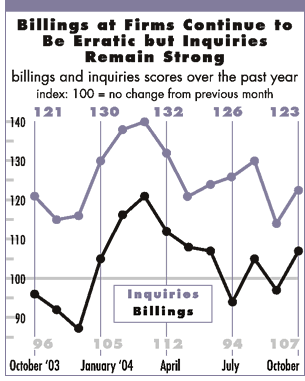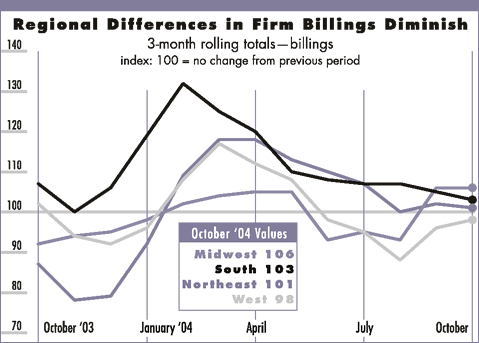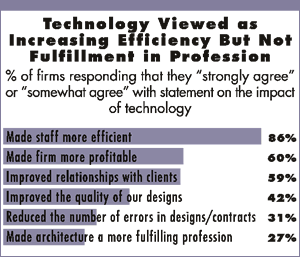

Billings at Firms Bouncing
Around, But Back up in October
Firms agree on benefits of technology to
employee productivity, but mixed on other positives

by Kermit Baker,
PhD, Hon. AIA
Chief Economist
 Billings at U.S. architecture firms bounced
back again in October. For the past several months, business trends
have followed a see-saw pattern of moving up one month and down the
next. This trend reflects the general uncertainty that we’ve
seen in the broader economy in recent months.
Billings at U.S. architecture firms bounced
back again in October. For the past several months, business trends
have followed a see-saw pattern of moving up one month and down the
next. This trend reflects the general uncertainty that we’ve
seen in the broader economy in recent months.
Regional trends in billings are beginning to even out. Firms in the South had been reporting much stronger conditions than firms in other regions for the past year. In recent months, however, firms in the other three regions have been catching up. Residential firms reported strong growth in billings in October, while commercial/industrial firms reported a slight decline.
Inquiries for new projects also showed gains in October, although inquiries have not shown the volatility of billings in recent months. Firms in the Midwest, as well as residential firms, reported the strongest gains in inquiries in October.
Economy generally good
Rising oil prices have held back growth in recent months, but October
was generally a good month for the economy. Business payrolls increased
by 337,000 in October, the second largest increase of the year. To
date, almost 2.0 million net new jobs have been added to the economy
this year, marking the strongest growth since 2000.
The construction industry also has done well on the employment front, adding 71,000 to payrolls in October and almost a quarter million through the first 10 months of the year. This should be the best year for gains in construction employment since 1999.

Both businesses and consumers seem to be breathing a sigh of relief
with the presidential election finally over and decided. The stock market
has rallied, and the preliminary numbers on consumer sentiment from the
University of Michigan show a fairly strong bounce in November.
The economy grew by 3.7 percent in the third quarter once the figures are seasonally adjusted and annualized, with business investment in software and equipment increasing by close to 15 percent at an annual rate. The strong level of technology spending that we’ve seen throughout the economy matches trends that we’ve seen at architecture firms.
 Technology: good for efficiency; mixed for everything else
Technology: good for efficiency; mixed for everything else
This month we asked firms to assess the impact of technology on their
practice. While almost all firms in our panel (86 percent) agreed that
technology has made their staff more efficient, there was less of a
consensus on the other impacts of technology.
Over half of firms agreed that technology had made them more profitable and had improved client relationships. Firms were mixed on whether technology had improved the overall quality of their designs. Firms disagreed that technology had reduced the number of errors in designs, and that technology has made architecture a more fulfilling profession. There were some differences in responses by size of firm. Smaller firms were more likely to agree that technology has made their firm more profitable. Larger firms were more likely to agree that technology had improved the quality of designs.
Copyright 2004 The American Institute of Architects.
All rights reserved. Home Page ![]()
![]()
 |
||
| This month, Work-on-the-Boards survey participants are saying: • There is more competition than there was before the slowdown,
as out-of-state firms establish a foothold here, which is at least
more active than their area. • Tenant fit-out work is on the rise. Build-to-suit work
still strong. • Our industry is stagnant right now in Albuquerque. • A large increase in interest in residential and small
commercial jobs. Large projects are waiting to see the results
of the elections.
|
||